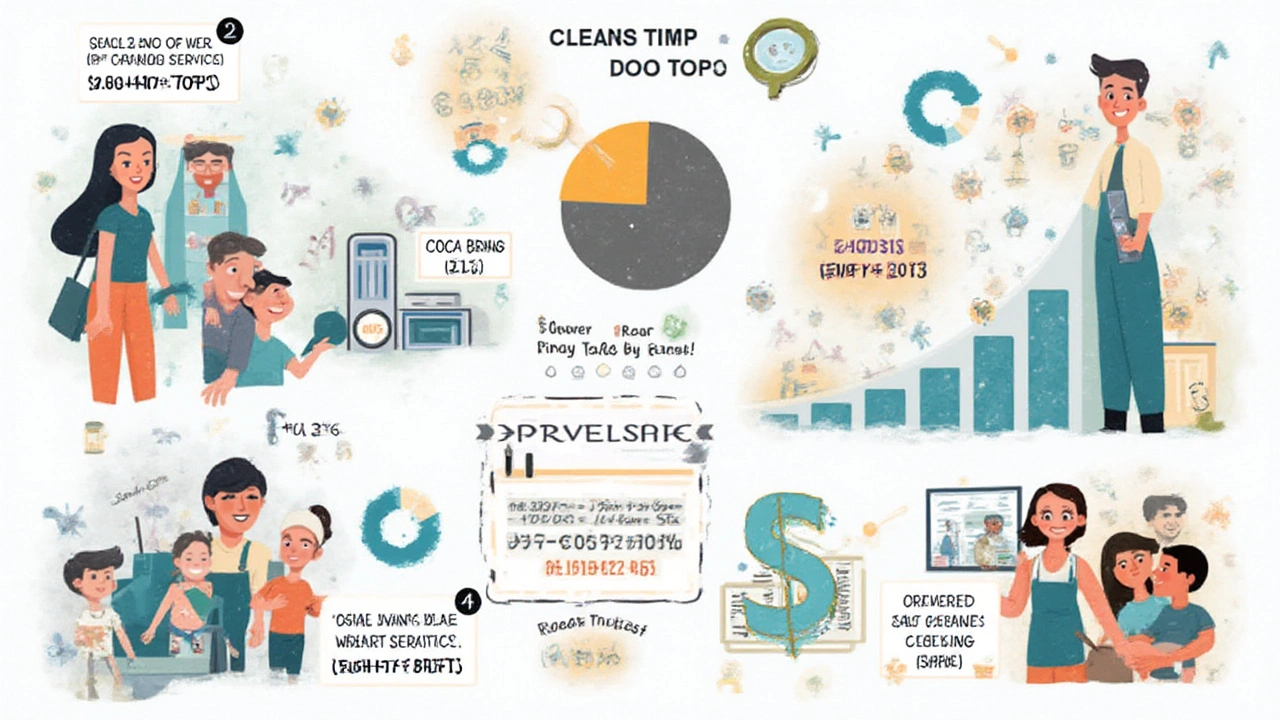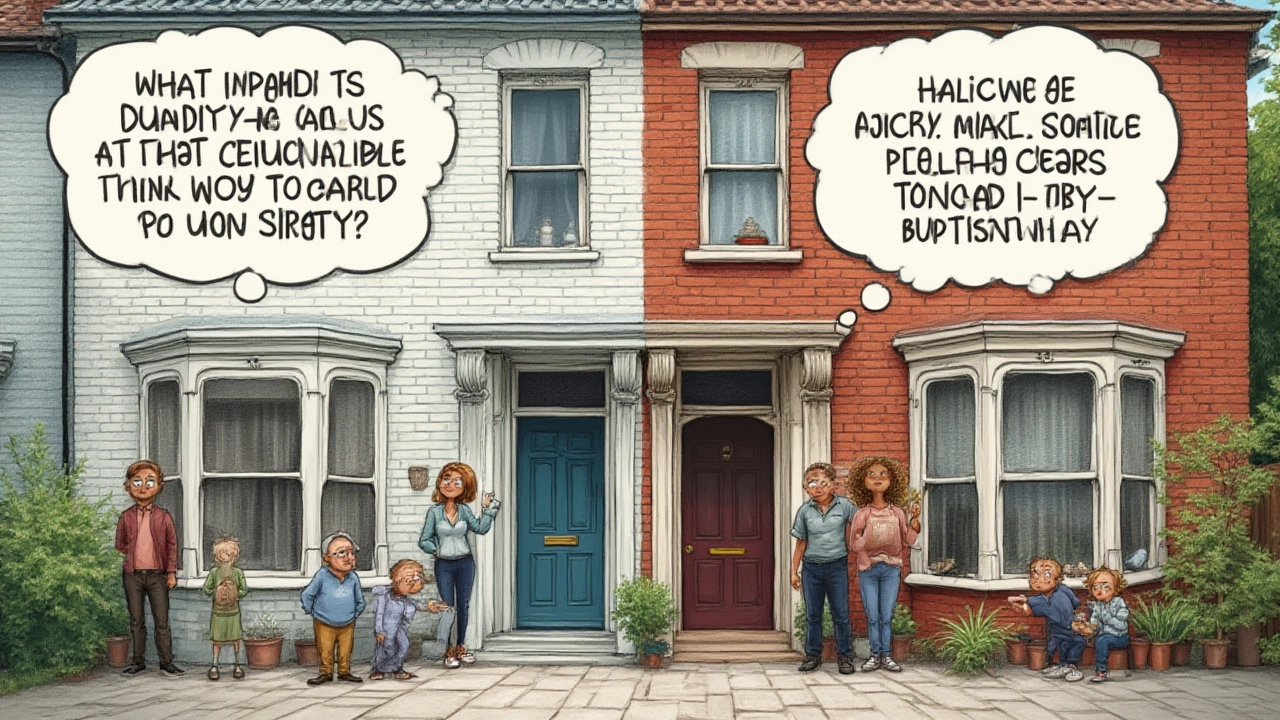Your friend just bragged about getting their whole place “deep cleaned” for less than a night’s bar tab. Then, there’s your neighbor, who claims they paid triple that for an average scrub-down. So what’s the deal—is there a secret cleaning service price list out there, or is everyone just winging it? Most people have no clue what a professional cleaning service costs now, or why the numbers jump all over the map. It’s not as simple as hourly rates: cleaning has leveled up big time, especially after the past few years of health scares and eco-friendly hype. Want straight answers and real talk? That’s exactly what you’ll find right here.
The Real Costs: Breaking Down Cleaning Service Prices
First thing: There is no one-size-fits-all price tag slapped on house cleaning. Anyone telling you differently probably hasn’t dealt with a pro company—at least, not recently. Still, most folk want a ballpark before the phone call. For a typical one-bedroom flat in a regular city, you’ll see rates between $90 and $180 for a standard clean by a professional service. That jumps for deep cleaning, usually starting around $160 but easily pushing $250 or more if you’ve let chores slide (hard truth: if your fridge looks haunted, you’ll pay extra).
What shakes up the numbers? Here’s the reality: houses with more than one bathroom nearly always cost more, not just linearly but as a multiplier, since bathrooms suck up supplies and staff time. According to HomeAdvisor’s actual booking data from spring 2025, the average American spends about $160 for a standard two-bedroom, two-bath clean. Add specialty services—like inside windows, ovens, or forgotten baseboards—and watch the total rise.
The US pricing scene is a buffet. In coastal areas and big cities, rates are higher—San Francisco averages $220 for a 2-bed clean while Atlanta sits closer to $140. Compare New York’s five-story walkups (they charge extra per flight of stairs) to suburban bungalows, and the upcharges stack up. If you’re booking with a national franchise, expect 10-15% higher fees for overhead and branded supplies. Independent local cleaners might undercut these rates but usually skip extras like insurance or fancy booking apps.
The frequency of cleaning works magic on cost. Weekly cleans are sometimes up to 30% cheaper per visit than rare deep-clean marathons: the logic is simple, less grime builds up, so it’s faster for pros. Some services offer monthly plans and deals for regular clients, trimming costs per clean but locking you in. Want a secret? If your schedule is flexible and you can book mid-week or last-minute, you might score a spontaneous deal, since cleaners want to fill off-peak slots.
The pandemic nudged prices up by about 20% since 2020—largely due to equipment upgrades, disinfectants, and hazard pay when COVID remained a risk. Those costs stuck around, especially for “disinfecting” add-ons. New in 2025: eco-friendly or “green” options. Services offering biodegradable products or zero-waste cleaning may charge a premium—on average, 10% more, according to EcoClean’s latest industry survey.
Wondering about hourly rates? For one-off jobs, pro services average $40–$75 per hour per cleaner, with team cleans (groups of two or more) working faster but not always cheaper. Watch out for minimum booking times; many companies won’t come out for under two hours, even if your place is tiny.
| Service Type | 2025 Avg. Price (USD) | Included Rooms |
|---|---|---|
| Standard Clean | $130 – $225 | 2-bed, 1-bath |
| Deep Clean | $200 – $400 | Whole home, high-detail |
| Move-in/Move-out | $250 – $500 | Whole home, extras |
| Hourly Rate | $40 – $75 | Per cleaner |
| Specialty (Oven, Fridge, etc.) | $30 – $60/item | Add-on to base service |
Watch for hidden costs: laundry, inside cabinets, or pet cleanup are often “extras,” not included in the base rate. Many services now send digital checklists after you book, showing what you’ve paid for. Use that to spot upsells—sometimes it’s worth it, especially if you’re prepping for a move or party, but you shouldn’t pay for things you don’t need.
Tips aren’t mandatory but are becoming common, with most clients adding 10-15%. Some services let you tip in-app, while old-school ones appreciate cash. If the team moved mountains (or mystery stains), don’t be shy about rewarding the effort.

What Drives the Price: Factors You Can—and Can’t—Control
You might think the size of your space is all that matters, but cleaning company quotes run deeper. Square footage is just a starting point. Pet owners get dinged extra, since hair and dander slow down every step (in one 2024 survey, homes with pets cost $35 more on average). Families with young kids? Upcharges for toys, sticky handprints, and that ever-mysterious trail of crumbs.
Bathrooms and kitchens eat the most time and supplies. For example, a 2-bed, 2-bath apartment will almost always cost at least $30 more than a place with one bathroom, even if the overall space is the same. Grease, mildew, and soapy buildup stretch cleaning times, so if you cook often or have hard water, you might see higher baseline costs. Want to shave down your bill? Tidy up kid/pet toys, laundry, or dishes yourself; cleaners focus on actual cleaning, not organizing your week’s clutter.
Whether your home is on the first floor or tucked up five flights matters—as does parking. Many companies now charge small travel fees in packed urban zones. If you’re in a rural spot miles from the nearest highway, expect fuel surcharges. Cleaning companies are more transparent about these fees now, after years of complaints about surprise add-ons post-clean.
If you’re a repeat customer, many services offer discounts for regular bookings, especially if you set up automated payments and keep your schedule. One insider tip: be loyal to a good team. Not only does it lock in a better rate, you’ll often get their “A-team.” Crews who know your space get faster, cut down mistakes, and skip unnecessary steps.
The time of year can play tricks with supply and demand. Around spring and autumn (aka “move-in/out season”), prices spike as tenants and landlords hustle to scrub before switching keys. Before holidays—especially Thanksgiving and Christmas—everyone seems to want a fresh space, and companies raise rates for prime slots. If you can book outside these waves, do.
What about those online price calculators? Good for a feel, but rarely exact. A pro will usually do a walk-through (in person or over video), especially for first-time cleans or big jobs, to scope out trouble zones. If you’ve skipped deep cleans for months, be honest—it’ll take longer and cost more, but it avoids fights or second trips later.
Modern cleaning now offers extras like COVID disinfection, hypoallergenic supplies, or kid-safe methods. These often bump up the bill 10-25%. Let’s not forget: insurance and background checks matter. Licensed, bonded companies almost always cost more, but if something goes wrong (broken vase, missing item), you’re safer and covered.
If you’ve got unique needs—like hoarding cleanouts, post-construction dust, or elderly care—expect a custom quote. That’s where specialist teams jump in, charging by job instead of square foot or hour. And if you’re still debating if pro cleaning is worth it, think about time saved. According to recent data from the US Bureau of Labor Statistics, the average urbanite spends nearly six hours a week on cleaning. Pay for a cleaning service, and that’s time won back instantly.

Getting the Most Value: Tips, Tricks, and Cost Hacks
No one likes overpaying, but you also don’t want to gamble on the cheapest cleaner online. So, how do you get the best bang for your cleaning buck in 2025? Start with this: price out at least three services, and don’t just glance at their overall quote—ask for itemized breakdowns. The lowest number isn’t always best: beware of rock-bottom bids with tons of surprise fees or subpar supplies.
Bundle and save isn’t just a cable myth. Bundling add-ons (windows plus fridge) in one visit usually costs less per service. Some companies now offer package deals: standard clean with a side of oven or steam carpet cleaning, shaving 10-20% off compared to booking each thing separately. If your home needs attention in certain spots only, ask for “partial cleans”—many services will quote for just kitchen/bathroom blitzes.
Flexible timing is a secret weapon. If your schedule isn’t locked, book on weekdays, mid-month, or during traditional “off” hours. Some cleaning companies release last-minute slots at lower prices to keep teams busy. Signing up for email alerts or loyalty programs sometimes means snagging deals regular clients never see.
Do a pre-clean. Sounds backward, but gathering up clothes, shoes, and random mess lets professionals focus on the toughest grime, shaving their labor costs and your final tally. Emptying the dishwasher ahead of time, moving small furniture, or even running a quick vacuum in high-traffic areas can cut your price, especially with local or independent cleaners.
If references or reviews ring alarm bells, listen. Always check recent feedback from verified clients, since a great price means nothing next to ruined paint or broken items. Ask companies about insurance—if they’re not covered, you’re at risk if something goes sideways. Don’t feel weird about confirming whether staff are background-checked; any reputable pro will expect it.
Cash doesn’t talk as sweetly as it used to, but some local cleaners still offer small discounts for paper payment, dodging processing fees. It never hurts to ask—it could save you 3-5% per visit. If you’re happy after a few cleans, negotiate a standing schedule for a small discount in exchange for regular work. Trust pays off for both sides.
Finally, remember: you can always start small. Try a one-time clean and see if the value is there. Most people, once they see the stress lifted and free time gained, become regulars—but you stay in the driver’s seat.
